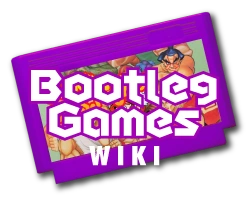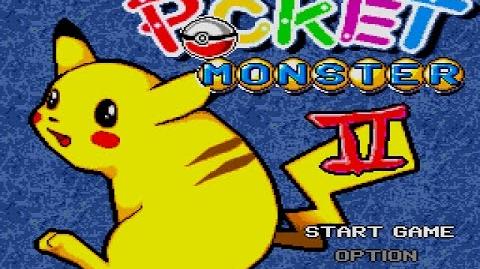(→Trivia) Tags: Visual edit apiedit |
No edit summary Tag: Source edit |
||
| (18 intermediate revisions by 13 users not shown) | |||
| Line 1: | Line 1: | ||
| + | {{About|Pocket Monster II|games with a similar title|Pocket Monster (disambiguation)}} |
||
| + | {{Infobox game |
||
| ⚫ | |||
| + | |image = File:PocketMonster2 title.png |
||
| ⚫ | |||
| + | |publisher = [[Unite Lucky Technology|X Boy]](?) |
||
| ⚫ | |||
| ⚫ | |||
| ⚫ | |||
| + | |engine = Pocket Monster platformer engine |
||
| ⚫ | |||
| + | }} |
||
| ⚫ | |||
| + | == Overview == |
||
| − | {{Infobox_game |
||
| ⚫ | This game shows significant improvements over the original, as both the artwork and audio have been improved, though the former is still mostly stolen from other games and it still shows all the previous glitches, in addition to a new one. The music is mostly remade from the Japanese Pokémon TV series, with songs including the original Japanese opening theme (Stage 1 and Stage 4) and the song 'Hyakugojyuichi' as the ending theme of the Japanese pilot as the boss theme in the game. |
||
| − | |image = Image:PocketMonster2_title.png |
||
| − | |imagewidth = 250 |
||
| ⚫ | |||
| − | |publisher = DVS Electronic Co. |
||
| ⚫ | |||
| ⚫ | |||
| ⚫ | |||
| ⚫ | |||
| ⚫ | |||
| ⚫ | |||
| + | This game is incredibly short overall, as it only contains four levels with a sole final boss at the end of the final one. However, the length of the game comes in punishing slightly careless actions with a very large amount of leaps of faith and overall blind jumps, in combination with the lack of checkpoints. Also, despite the game has very few stages, they're incredibly long, so all of this makes the game aggravating at times. Falling down is almost a guarantee if you don't have the map completely memorized. However, the plentiful extra life pickups, which regenerate upon death, keep you from getting a Game Over too soon. The four levels themselves are also incredibly generic. They have no names, but their themes are the following: forest, canyon/valley, castle, and power plant. The only one of the four levels with a specific mechanic is the third, with a button-activated door. |
||
| ⚫ | This game |
||
| ⚫ | |||
| ⚫ | |||
| − | ==Summary== |
||
| − | This game is incredibly short overall, almost painfully so. It only contains four levels, with an end boss. However, the length of the game comes in punishing slightly careless actions with a very large amount of leaps of faith and overall blind jumps, in combination with the lack of checkpoints. This makes the game aggravating at times. |
||
| ⚫ | |||
| − | The four levels are also incredibly generic. They have no names, but their themes are the following: forest, canyon/valley, castle, and power plant. The only one of the four levels with a specific mechanic is the third, with a button-activated door. |
||
| ⚫ | Here you move with the control pad and jump with the 'C' button. Unlike in ''Pocket Monster'', Pikachu cannot use a screen-wide electric attack. Instead, he can toss Poké Balls with the 'B' button when they are collected. You can kill enemies with them, but are rather useless thanks to their lacking range and the fact that you drop all of your Poké Balls when you get hit. |
||
| ⚫ | |||
| − | As mentioned before, the game punishes any mistake you make. Falling down is almost a guarantee if you don't have the map completely memorized. However, the plentiful extra life pickups, which regenerate upon death, keep you from getting a Game Over too soon. |
||
| ⚫ | |||
| − | It's no surprise that this has more than a couple of glitches... |
||
*Pikachu can only control the height of his jump while standing perfectly still, making it incredibly difficult to dodge certain enemies while progressing through the stage. |
*Pikachu can only control the height of his jump while standing perfectly still, making it incredibly difficult to dodge certain enemies while progressing through the stage. |
||
*On that same note, Pikachu can jump down from vertically moving platforms (moving up) if he jumps too low. |
*On that same note, Pikachu can jump down from vertically moving platforms (moving up) if he jumps too low. |
||
| − | *The moving platforms can sometimes disappear if they are by the edge of the screen, due to objects being programmed to disappear if they scroll off screen. |
+ | *The aforementioned moving platforms can sometimes disappear if they are by the edge of the screen, due to objects being programmed to disappear if they scroll off screen. |
| ⚫ | |||
| − | *There's an odd glitch that causes random hits on pokemon due to iffy hit detection. This is common in other bootleg games. |
||
| ⚫ | |||
| − | **Using a certain variation of this glitch, you can defeat the final boss easily. |
||
| + | *Sometimes, when you throw a Poké Ball to an enemy, the game freezes. It seems to happen both on emulators and on real hardware. |
||
| ⚫ | |||
| ⚫ | |||
== Trivia == |
== Trivia == |
||
| − | * |
+ | *Some music tracks from this game were reused in ''Fengkuang Dafuweng'' (aka Crazy Richman/Crazy Monopoly) by [[Vast Fame]]. |
| − | * |
+ | *The level graphics from level 2 seem to be taken from [[Mega Man#Mega Man X|''Mega Man X'']]'s (SNES) Sting Chameleon stage. |
| ⚫ | |||
| − | * |
+ | *The level graphics from level 4 are taken from ''Sparkster'' on the SNES and some of the enemies are taken from a variety of Mega Drive games including ''Mega Bomberman'' and ''Magical Taluluto'' (the latter, fittingly, was developed by Game Freak, the creators of ''Pokémon''.). |
| − | * |
+ | *The crab and the blue monkey from the first level were stolen from an original licenced Sega Genesis game ''Wonder Boy in Monster World'' by Westone. |
| ⚫ | |||
| ⚫ | |||
| ⚫ | |||
| ⚫ | |||
| − | |||
| − | |||
| − | |||
| − | |||
| − | |||
| − | |||
| − | |||
| − | |||
| − | |||
| ⚫ | |||
<gallery> |
<gallery> |
||
PocketMonsterII_MD_Cart.jpg|The cartridge. |
PocketMonsterII_MD_Cart.jpg|The cartridge. |
||
| + | PocketMonsters2BoxArt.png|''Pocket Monsters II''<nowiki>'</nowiki>s box art. |
||
</gallery> |
</gallery> |
||
| ⚫ | |||
| − | == References and External Links== |
||
| + | <gallery> |
||
| ⚫ | |||
| ⚫ | |||
| + | </gallery> |
||
| + | |||
| + | == External Link == |
||
| ⚫ | |||
| ⚫ | |||
[[Category:Mega Drive/Genesis games]] |
[[Category:Mega Drive/Genesis games]] |
||
| ⚫ | |||
[[Category:Platform games]] |
[[Category:Platform games]] |
||
| − | [[Category: |
+ | [[Category:Chuanpu]] |
[[Category:DVS Electronic Co.]] |
[[Category:DVS Electronic Co.]] |
||
| + | [[Category:2001 video games]] |
||
| + | [[Category:Pokémon games]] |
||
| + | [[Category:Ripped graphics]] |
||
Revision as of 20:46, 11 January 2021
- This article is about Pocket Monster II. For games with a similar title, see Pocket Monster (disambiguation).
Pocket Monster II is a platform game for the Sega Mega Drive and a direct sequel to Pocket Monster, both probably developed by ex-workers from Chuanpu Technology and perhaps published by X Boy.
Overview
This game shows significant improvements over the original, as both the artwork and audio have been improved, though the former is still mostly stolen from other games and it still shows all the previous glitches, in addition to a new one. The music is mostly remade from the Japanese Pokémon TV series, with songs including the original Japanese opening theme (Stage 1 and Stage 4) and the song 'Hyakugojyuichi' as the ending theme of the Japanese pilot as the boss theme in the game.
This game is incredibly short overall, as it only contains four levels with a sole final boss at the end of the final one. However, the length of the game comes in punishing slightly careless actions with a very large amount of leaps of faith and overall blind jumps, in combination with the lack of checkpoints. Also, despite the game has very few stages, they're incredibly long, so all of this makes the game aggravating at times. Falling down is almost a guarantee if you don't have the map completely memorized. However, the plentiful extra life pickups, which regenerate upon death, keep you from getting a Game Over too soon. The four levels themselves are also incredibly generic. They have no names, but their themes are the following: forest, canyon/valley, castle, and power plant. The only one of the four levels with a specific mechanic is the third, with a button-activated door.
Controls
Here you move with the control pad and jump with the 'C' button. Unlike in Pocket Monster, Pikachu cannot use a screen-wide electric attack. Instead, he can toss Poké Balls with the 'B' button when they are collected. You can kill enemies with them, but are rather useless thanks to their lacking range and the fact that you drop all of your Poké Balls when you get hit.
Glitches
- Pikachu can only control the height of his jump while standing perfectly still, making it incredibly difficult to dodge certain enemies while progressing through the stage.
- On that same note, Pikachu can jump down from vertically moving platforms (moving up) if he jumps too low.
- The aforementioned moving platforms can sometimes disappear if they are by the edge of the screen, due to objects being programmed to disappear if they scroll off screen.
- Pikachu can jump again after jumping on a Pokémon, which also applies to whenever Pikachu is damaged.
- When a Poké Ball is tossed and on-screen, it moves as Pikachu does.
- Sometimes, when you throw a Poké Ball to an enemy, the game freezes. It seems to happen both on emulators and on real hardware.
Trivia
- Some music tracks from this game were reused in Fengkuang Dafuweng (aka Crazy Richman/Crazy Monopoly) by Vast Fame.
- The level graphics from level 2 seem to be taken from Mega Man X's (SNES) Sting Chameleon stage.
- The level graphics from level 3 are taken from Pink Goes To Hollywood.
- The level graphics from level 4 are taken from Sparkster on the SNES and some of the enemies are taken from a variety of Mega Drive games including Mega Bomberman and Magical Taluluto (the latter, fittingly, was developed by Game Freak, the creators of Pokémon.).
- The crab and the blue monkey from the first level were stolen from an original licenced Sega Genesis game Wonder Boy in Monster World by Westone.

